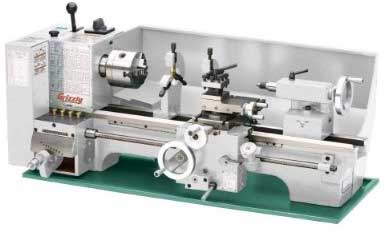
Selecting a Lathe
|
Purchasing a lathe can be a bewildering experience, and at times very disappointing if one has not done their homework. Lathes come in three sizes, too big, too small or just right, so the lathe you select very much depends on what you will be using it for. Small parts can be turned on a large lathe but it just doesn't feel right, everything around the part is just too big. Large parts can not be turned on a small lathe if they exceed the lathes capacity so a lathe should be selected to fit the type of work that will be done on it most of the time. Lathes also come in two styles, screw cutting and plain, most lathes today are screw cutting with the exception of a few small hobby lathes. There are attachments for some of the hobby lathes to converet them to cut threads but it is probably best to settle for a proper screw cutting lathe to start with. Once you have determined the size you require the decision will have to made whether to buy a new one or one that has been preowned. There are pros and cons to both routes. Pros of a new lathe: New machines have a warranty, they are complete though basic, larger machines may be leased or bought on payments. Many new lathes, particularily the smaller ones, have to be tuned up to work properly. Cons of a new lathe: Most accessories will have to be purchased separately, the new lathes are more expensive than used ones. Pros of a preowned lathe: They often have more accessories included and will have been tuned by the previous owner. Cons of a preowned lathe: There may be missing, broken or worn parts. It is always wise for anyone not familiar with lathes to have an experienced machinist with them when looking to buy a used lathe. Parts of a Lathe Before purchasing a lathe one should make themselves familiar with the parts of a lathe and what they do. This page has a drawing of a lathe and explains the various components. Size of a Lathe The size of a lathe is determined by the swing over the bed and the distance between the centers. A lathe referred to as a "7 X 18" would be able to turn material 7" in diameter and 18" in length. Some models may have a gap bed where there is a cut out in front of the headstock to allow for a larger swing, in that case the lathe would be referred to as a "7 X 18 Gap Bed" lathe. The size of the taper in the spindle will vary with the size of the lathe, small hobby lathes may have a # 0 or #1 Morris taper, most hobby lathes will have a #3 or #4 Morris Taper. The thread on the spindle stub will vary as well, some Sears lathes had a 1/2" - 20 TPI, but most hobby lathes will be at least a 3/4 -16TPI or larger. Not all lathes have a threaded spindle some have a flange that the chuck bolts to. Tooling for a Lathe It is not unusual to spend almost as much on tooling as you spend on the purchase of the lathe, fortunately this does not have to be spent all at once. A common mistake made by new owners is to purchase a lot of expensive tooling with the lathe and then find that much of it is seldom, if ever used. Take your time and purchase the extras as needed, you will also find that many attachments can be shop made as your skill increases. This page lists some of the tooling you will need for your lathe. Tuning Your Lathe There will come a time when it is necessary to tune up your lathe, even a new lathe over time may come out of alignment and you find you are cutting tapers, it is not that difficult to align your lathe again.
|
` |
Related Pages Lathe Manufactures Operating Instructions Turning & Boring on a Lathe
|
